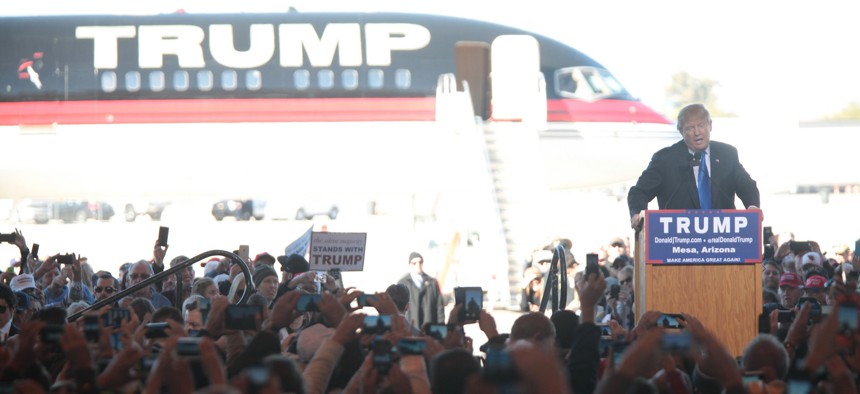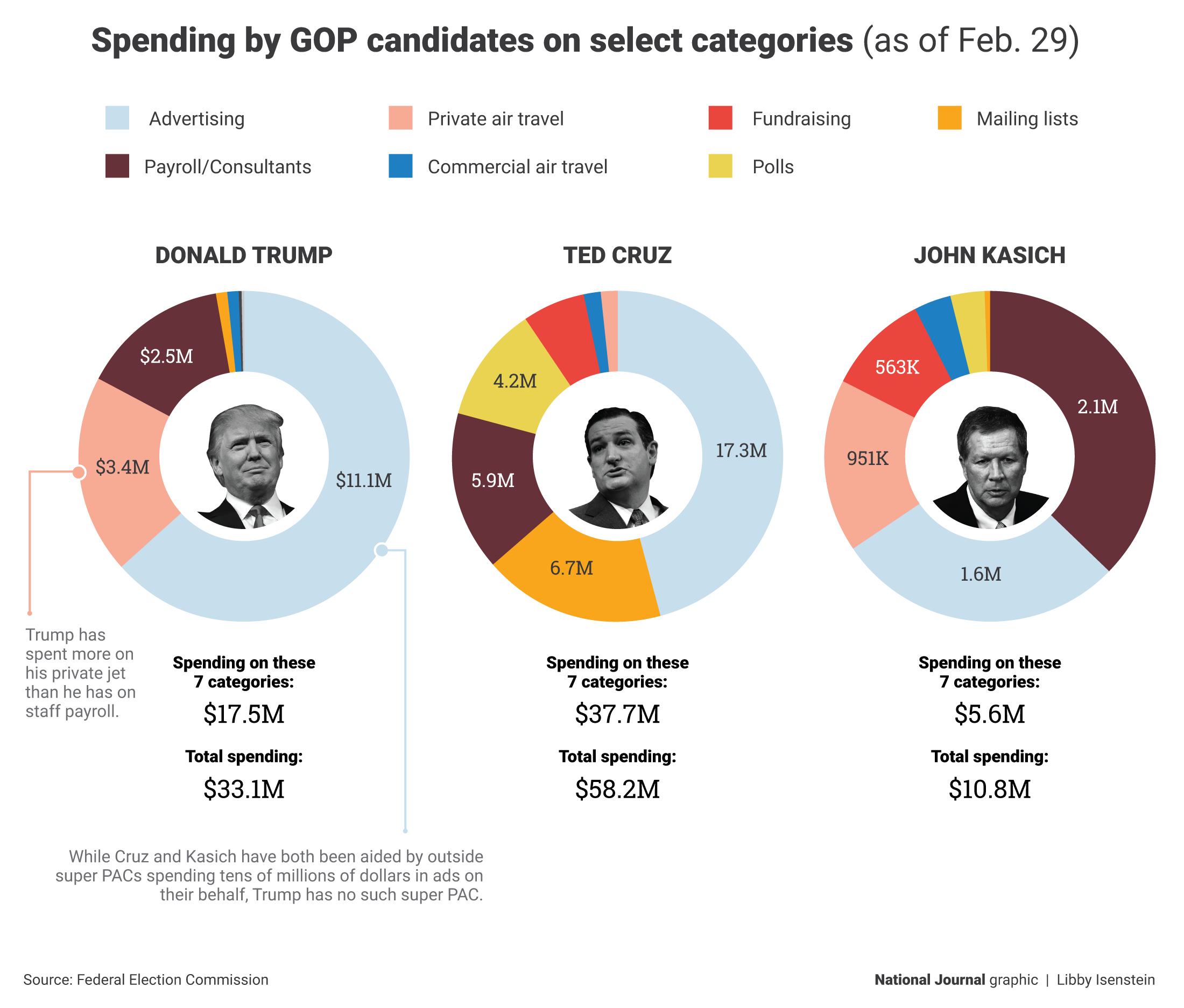
Trump speaks to supporters in Arizona in front of his jet in December. Flickr user Gage Skidmore
Trump Spends More On Jet Fuel Than On Staff
Frugal except about personal comforts, he burns through some $3 million on his Boeing 757 so he can sleep at home in Manhattan or Florida.
Republicans desperate to keep Donald Trump from their nomination can at least be thankful for this: When choosing between buying fuel for his luxury jetliner or a larger campaign staff, Trump has opted for jet fuel.
From the start of his presidential campaign through the end of February, Trump’s spending on private air travel, primarily his kerosene-guzzling Boeing 757, totaled $3.4 million—about a third more than he spent on payroll and political consultants, according to a National Journal analysis of Federal Election Commission filings.
The upshot? Trump and a handful of aides swoop to his rallies in style aboard an airplane large enough to carry 200 passengers, but GOP meetings at the county and congressional-district level around the country have gone unstaffed by the Trump campaign, allowing scores of delegates loyal to Sen. Ted Cruz to win slots to the summer nominating convention.
Trump campaign aides did not reply to National Journal queries. But GOP strategists critical of Trump’s candidacy said his choices are not surprising, given his reputation as being tightfisted about most spending yet extravagant when it comes to his personal comfort.
“He’s a narcissistic baby,” said Florida’s Rick Wilson, who supported Sen. Marco Rubio’s bid and is now a key activist in the “Never Trump” movement.
Trump does also own a Cessna Citation X, an eight-passenger business jet that uses less than half as much fuel as the 757, which burns through $10,000 worth each hour. Trump has only used the smaller plane occasionally, when a campaign event is being held in a town that doesn’t have a sufficiently long runway nearby.
The fondness for the bigger plane, which boasts a stateroom and a shower, has been an expensive one, particularly with Trump’s preference to spend every night at either his New York City apartment or Mar-a-Lago, his Palm Beach estate. Rather than incurring costs of hundreds of dollars a night for hotel rooms, he has been spending tens of thousands of dollars so he can awaken in his own bed.
Had he used the smaller plane instead, he could have saved upwards of $1 million—enough to have hired dozens more full-time staffers over the past year.
“It doesn’t shock me that he’s basically thrown money into a shredder, spending all that money for his plane. It doesn’t shock me at all,” Wilson said.
No other candidate has spent so much on private air travel compared to payroll. Cruz, his nearest remaining Republican rival, spent $5.9 million on payroll and political consultants through Feb. 29 (the latest filing available) but only $568,000 on private planes. Democratic front-runner Hillary Clinton spent $35 million on staff and $3.7 million on private air travel—although some of that was reimbursed to the campaign by members of Clinton’s traveling press corps.

Trump has in recent weeks hired several high-level aides in an effort to secure the 1,237 delegates needed for the GOP nomination, including Paul Manafort and Rick Wiley. Manafort is a longtime Washington lobbyist and consultant who in 1976 helped President Ford hold off a challenge from Ronald Reagan, while Wiley most recently ran Wisconsin Gov. Scott Walker’s short-lived presidential bid. How much they are paid and whether on-the-ground staff is also being added in states that are choosing delegates this month will not be disclosed in the FEC filings until mid-May.
But through much of the campaign, Trump has resisted hiring staff, citing his high rankings in public polls to justify the approach. Through Nov. 1, the Trump campaign had paid a grand total of 15 staffers and political consultants. In contrast, Cruz had paid 75 by that date.
One Republican consultant said privately that Trump’s Iowa strategist, Chuck Laudner, lobbied hard for more on-the-ground workers in that first-to-vote state. “They didn’t listen to Laudner in Iowa, lost, then blamed him,” the consultant said. “Now, they’re paying for it. Chuck has so many connections in Iowa and other states, he could have really helped with the delegate process. Missed opportunity for them.”
Laudner declined to discuss his work for Trump with National Journal. Trump’s FEC filings show Laudner and the consulting firm registered to his wife were paid $210,665 through the end of February. Laudner, in fact, is among five top Trump aides who among them received more than $1 million of the $2.5 million Trump spent on payroll and political consultants. Campaign manager Corey Lewandowski’s consulting firm was paid $321,098; James Merrill’s South Carolina firm made $307,472; Michael Glassner and his firm were paid $182,071, and social-media director Dan Scavino was paid $85,000.
Trump by the start of February appeared to have caught up with Cruz in staffing, with 109 paid employees and political consultants compared to 108 for Cruz. The figures for March will be available next week. Those filings will also reveal how much more of his own money Trump has put into his effort. So far, Trump has lent his campaign $24.4 million of the $33 million he has spent. Much of the rest has come from the sale of hats, T-shirts, and other paraphernalia.
While Trump frequently claims a net worth of $10 billion, a National Journal review of his financial disclosure filing and reports of court transcripts found that he is likely worth considerably less—and in any event only had between $78 million and $232 million in relatively liquid assets when he began his campaign last year
(Top image via Flickr user Gage Skidmore)






